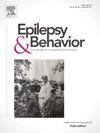Diagnosis of NCSE in elderly patients with impaired level of consciousness treated in the emergency department of a general hospital
IF 2.3
3区 医学
Q2 BEHAVIORAL SCIENCES
引用次数: 0
Abstract
An impaired level of consciousness is common in elderly patients treated in the emergency department. However, the rate of occurrence of nonconvulsive status epilepticus (NCSE) is not yet known.
Objective
To evaluate the occurrence of NCSE in patients aged ≥ 60 years who presented with a decreased level of consciousness in the emergency department of a general hospital. The study also compared the clinical and EEG findings and 30-day mortality rates between patients diagnosed with NCSE and those with other diagnoses.
Methodology
During the year 2023, patients aged ≥ 60 with a consciousness impairment who were admitted to the emergency department of the PUC-Campinas hospital and submitted to EEG at admission were consecutively included. According to the clinical-EEG aspects, the cases were classified into the NCSE and “other diagnoses” groups. Clinical variables and the 30-day mortality rate were compared between the groups.
Results
Of 124 elderly included (mean age 73.9 ± 8.0 years; 64 females), the diagnosis of NCSE was made in 31 (25 %) cases and of “other diagnoses” in 93 (75 %) cases. There was no difference between the groups in age, gender, history of epilepsy, etiology (acute vs. non-acute), and the characteristics of the initial clinical manifestation. In the EEG, there was a high occurrence of delta or theta rhythm and epileptiform discharges (EDs) in the NCSE group. Within 30 days, 46 (37 %) patients died. Mortality was higher in the NCSE group [T test; 20 (64.5 %) vs. 26 (27.9 %); p < 0.001], in cases with acute etiology, with EDs on the EEG, and when the clinical presentation was coma.
Conclusion
NCSE occurred in 25% of the elderly with impaired consciousness who were treated in the emergency department of a general hospital. Unlike the clinical manifestations, the EEG findings differed between elderly patients with NCSE and those with other diagnoses. The mortality rate was high, and there was a higher occurrence in the NCSE.
某综合医院急诊科收治的老年意识受损患者NCSE的诊断
在急诊科治疗的老年患者中,意识受损是很常见的。然而,非惊厥性癫痫持续状态(NCSE)的发生率尚不清楚。目的评价某综合医院急诊科≥60岁伴有意识水平下降的NCSE患者的发生情况。该研究还比较了诊断为NCSE和其他诊断的患者的临床和脑电图结果以及30天死亡率。方法连续纳入2023年在芝加哥州立大学坎皮纳斯医院急诊科就诊并入院时行脑电图检查的60岁以上意识障碍患者。根据临床-脑电图情况将病例分为NCSE组和其他诊断组。比较两组临床变量和30天死亡率。结果124例老年人(平均年龄73.9±8.0岁;64例(女性)中,31例(25%)诊断为NCSE, 93例(75%)诊断为其他诊断。两组在年龄、性别、癫痫史、病因(急性与非急性)、首发临床表现等方面无差异。在脑电图中,NCSE组出现高频率的δ或θ节律和癫痫样放电(EDs)。30天内,46例(37%)患者死亡。NCSE组死亡率较高[T检验;20 (64.5%) vs. 26 (27.9%);p & lt;0.001],在急性病因,脑电图上有EDs,临床表现为昏迷的情况下。结论在综合医院急诊科就诊的老年意识障碍患者中,有25%发生了ncse。与临床表现不同,老年NCSE患者的脑电图表现与其他诊断不同。死亡率高,且在NCSE地区发病率较高。
本文章由计算机程序翻译,如有差异,请以英文原文为准。
求助全文
约1分钟内获得全文
求助全文
来源期刊

Epilepsy & Behavior
医学-行为科学
CiteScore
5.40
自引率
15.40%
发文量
385
审稿时长
43 days
期刊介绍:
Epilepsy & Behavior is the fastest-growing international journal uniquely devoted to the rapid dissemination of the most current information available on the behavioral aspects of seizures and epilepsy.
Epilepsy & Behavior presents original peer-reviewed articles based on laboratory and clinical research. Topics are drawn from a variety of fields, including clinical neurology, neurosurgery, neuropsychiatry, neuropsychology, neurophysiology, neuropharmacology, and neuroimaging.
From September 2012 Epilepsy & Behavior stopped accepting Case Reports for publication in the journal. From this date authors who submit to Epilepsy & Behavior will be offered a transfer or asked to resubmit their Case Reports to its new sister journal, Epilepsy & Behavior Case Reports.
 求助内容:
求助内容: 应助结果提醒方式:
应助结果提醒方式:


